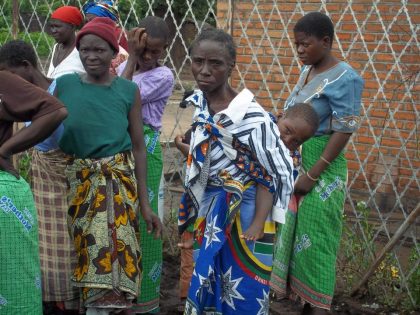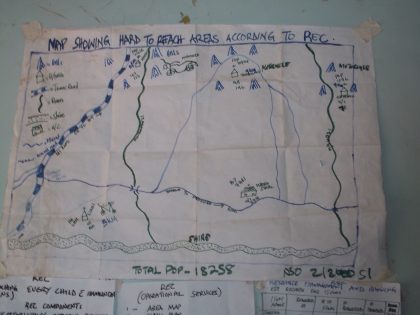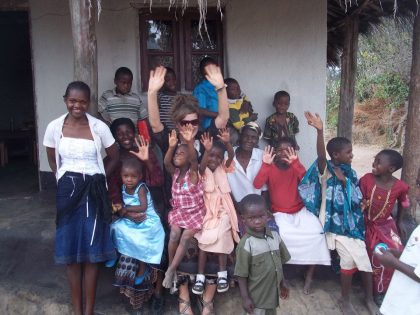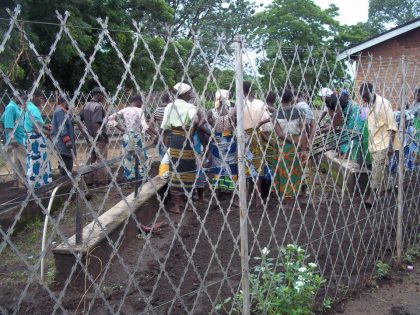 Location
Location
Mfera Catchment Area, Chickwawa District, Malawi
Community Description
Mhemela and Mushuli villages are located in the Thabwani section of the Mfera catchment area in Chickwawa. There are 21,851 people living in the area in 53 registered villages according to the most recent National Statistics Office report.
The villages are approximately 5 km apart, but it is an 8 km trip by motorcycle between them. They are 12 km from the health center. The roads to the villages are only accessible by walking and motorcycles in the dry season.
Within the catchment area there are two unprotected springs in the mountainous and hardest-to-reach villages. In these villages, they have had frequent cholera outbreaks due to lack of access to clean and sanitary water. These places do not have boreholes and currently are drinking from stream beds 1-2km downhill from the villages.
 The Thabwani section with access to the freshwater springs has 10 registered villages totaling approximately 6,500 and another 3 unregistered villages. The next closest villages that will access the springs are Chriomo 1,2,3 (886, 401, and 309 people) and Zinthole 1,2 (309, 195 people), which also fall in the Thabwani section of the catchment area.
The Thabwani section with access to the freshwater springs has 10 registered villages totaling approximately 6,500 and another 3 unregistered villages. The next closest villages that will access the springs are Chriomo 1,2,3 (886, 401, and 309 people) and Zinthole 1,2 (309, 195 people), which also fall in the Thabwani section of the catchment area.
Currently, the springs have been dug out by the local villagers and are being treated like very shallow wells, with buckets to scoop up the muddy water.
Project Description
This project is to protect and build up two natural springs located in the mountains to provide safe water for the villages.
Under the direction of the Mfera Community Action Group, the springs will be protected from animals and built up using pipes and cement to provide a sanitary area to retrieve water.
 A small covered dam will be built, with one hole and piping coming from the side of the structure. This pipe will provide a continuous gravity-fed water supply that will be flowing over a drainage system that will lead to an area for washing clothes and further feeding a local community garden. The dam structure will also have an additional drainage hole for any refuse that may gather within the dam despite it being covered.
A small covered dam will be built, with one hole and piping coming from the side of the structure. This pipe will provide a continuous gravity-fed water supply that will be flowing over a drainage system that will lead to an area for washing clothes and further feeding a local community garden. The dam structure will also have an additional drainage hole for any refuse that may gather within the dam despite it being covered.
The community garden that will surround the spring water dam will help ensure that no water accumulates, thereby decreasing the potential for mosquito and other sanitation issues from standing water accumulating.
The community will participate by providing the labor needed to create ease of access to the water, and they will provide a fence to keep animals further from the fresh water. A local recommended contractor from the DHO will provide the physical work on the project.
In addition to providing the fencing to surround the garden and springs, the community will also carry the sand, bricks, and stones, and help in digging out the area for the cement dam to be built.
 Water Charity funds will be used to purchase the materials. In addition, the funds will be used for 2 allowances of K3,000 (~$8.57 each) for the District Hospital Water Contractors to come and facilitate the building of the structures. The funding will also pay K15,000 (~$42.86) for fuel to transport the materials to the remote areas.
Water Charity funds will be used to purchase the materials. In addition, the funds will be used for 2 allowances of K3,000 (~$8.57 each) for the District Hospital Water Contractors to come and facilitate the building of the structures. The funding will also pay K15,000 (~$42.86) for fuel to transport the materials to the remote areas.
Local leaders have agreed on the importance of protecting the springs and will elect a local village water boards for maintenance of the springs and surrounding area.
Project Impact
2,500 people will benefit from the project.
Peace Corps Volunteer Directing Project
Emily DeLacey
Comments
This is an important infrastructure project that will have a profound impact on two communities. In providing clean and readily accessible water, it will improve the health and well-being of a large number of people.
Dollar Amount of Project
$500.00
Donations Collected to Date
$500.00
Dollar Amount Needed
$0.00 – This project has been fully funded, through the generosity of Michael and Carla Boyle, of Nelsonville, OH, USA.
This project has been finished. To read about the conclusion of the project, CLICK HERE.